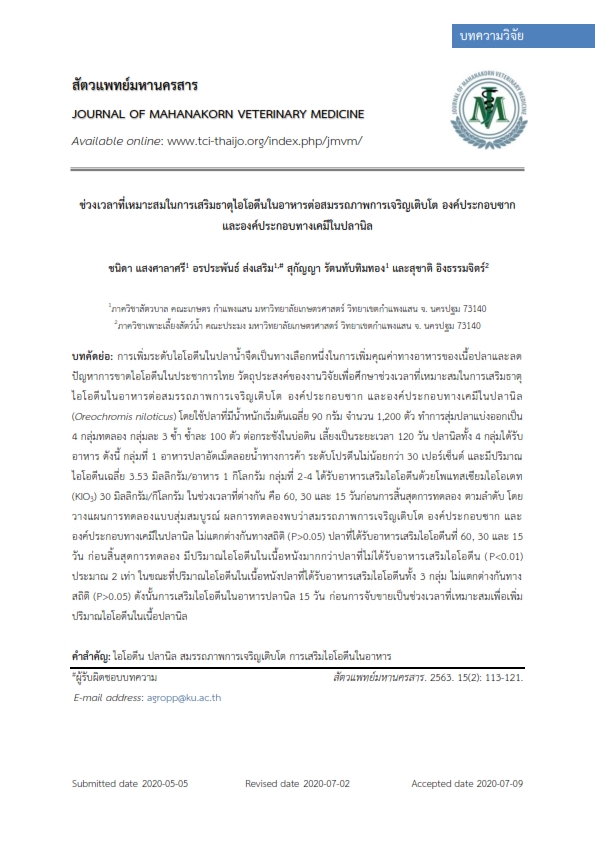Optimal Period for Iodine Supplementation in Diet on Growth Performance, Carcass Composition and Chemical Compositions of Tilapia (Oreochromis niloticus)
Main Article Content
Abstract
Increasing iodine level in freshwater fish is an alternative to increase the nutritional value of flesh and reduce iodine deficiency problems in Thai population. The objective of the research is to study on optimal period for iodine supplementation in diet on growth performance, carcass composition and chemical composition of tilapia (Oreochromisniloticus). One thousand and two hundred tilapia with the average weight of 90 g/fish were randomly divided into 4 groups with 3 replications. One hundred fish replicate were raised in a cage in the earthen pond for a period of 120 days. All groups of tilapia received the following diets: Group 1 commercial fish floating diet with at least 30% protein and the average amount of iodine is 3.53 mg/kg. Group 2-4 received diet supplemented with potassium iodate (KIO3) 30 mg/kg at different periods (60, 30 and 15 days prior to the end of the experiment). The experiment was conducted with completely randomized design (CRD). The results found that growth performance, carcass composition and chemical composition of tilapia were not significantly differences (P>0.05). Fish that received iodine supplementation at 60, 30 and 15 days prior to the end of the experiment had doubled flesh iodine content comparing to fish without iodine supplementation (P<0.01), while flesh iodine content of the other groups were not significantly differences (P>0.05). Therefore, providing iodine supplemented diet for 15 days before harvesting is optimal for increasing the amount of iodine in tilapia flesh.
Article Details
References
A.O.A.C. 1990. Association of official, chemists, official methods of analysis 15th Edition. Washington DC, U.S.A.
Bureau of Nutrition. 2015. Guidelines for the control and prevention of iodine Deficiency Disorders. Department of Health, Ministry of Public Health, Bangkok. 50 p. (in Thai)
Demaeyer, E. M., F. M. Lowenstein, and C. H. Thilly. 1979. The Control of Endemic Goitre. WHO, Geneva. 20 p.
Erkan, N. 2011. Iodine content of cooked and processed fish in Turkey. Int. J. Food Sci. Technol. 46: 1734–1738.
Gokoglu, N., P.Yerlikaya, and E. Cengiz. 2004. Effects of cooking methods on the proximate composition and mineral contents of rainbow trout (Oncorhynchus mykiss). Food Chem. 84(1): 19-22.
Julshamn, K., A. Maage, R. Waagb, and A. K. Lundebye. 2006. A preliminary study on tailoring of fillet iodine concentrations in adult Atlantic salmon (Salmo salar L.) through dietary supplementation. Aquacult. Nutr. 12: 45–51.
Karl, H., W. Munkner, S. Krause, and I. Bagge. 2001. Determination, Spatial Variation and Distribution of Iodine in Fish. Behr's Verlag, Hamburg, Allemagne.
McDowell, L. R. 1992. Minerals in Animal and Human Nutrition. Academic Press Inc., San Diego, California.
Ministry of Public Health. 1993. Notification of the Ministry of Public Health No.151 (1993) Re: Prescription of prohibit substances in food. Available Source: http://food.fda.moph.go.th/law/data/announ_moph/P151.pdf. June 3, 2020. (in Thai)
Moxon, R. E. D. and E. J. Dixon. 1980. Semi-automatic method for the determination of total iodine in food. Analyzt. 105: 344-352.
Ribeiro, A. R., A. Gonçalves, R. Colen, M. L. Nunes, M. T. Dinis, and J. Dias. 2015. Dietary macroalgae is a natural and effective tool to fortify gilthead seabream fillets with iodine: Effects on growth, sensory quality and nutritional value. Aquaculture. 437: 51–59.
Salasawat, N. 2019. Evaluation of iodine losses according to different cooking procedures in Tilapia (Oreochromis niloticus) fed with iodine supplementation. M.E. Thesis, Kasetsart University. (in Thai)
Schmid, S., D. Ranz, M. L. He, S. Burkard, M. V. Lukowicz, R. Reiter, R. Arnold, H. Le Deit, M. David, and W. A. Rambeck. 2003. Marine algae as natural source of iodine in the feeding of freshwater fish a new possibility to improve iodine supply of man. Rev. Méd. Vét. 1541(10): 645-648.
Supakitjananon, T., K. Meng-amber, and D. Amornlertphisan. 2014. Development of increased value-added products from hybrid catfish: Technology for aquaculture to increase production for comercial purpose and improve the competition ability. Maejo University, Chiang Mai. p. 49 (in Thai)
Valente, L.M.P., A. Gouveia, P. Rema, J. Matos, E.F. Gomes, and I.S. Pinto. 2006. Evaluation of three seaweeds Gracilaria bursa-pastoris, Ulva rigida and Gracilaria cornea as dietary ingredients in European sea bass (Dicentrarchus labrax) juveniles. Aquaculture. 252: 85–91.
Valente, L. M. P., P. Rema, V. Ferraro, M. Pintado, I. S. Pinto, L. M. Cunha, M. B. Oliveira, and M. Araújo. 2015.Iodine enrichment of rainbow trout flesh by dietary supplementation with the red seaweed Gracilaria vermiculophylla. Aquaculture. 446: 132–139.
Thianthavorn, W. 1989. The health effects of iodine deficiency disorder. Proceedings of the Nutrition Conference 1989: Update on Nutrition for Health, 13-15th December 1989, Mahidol University, Bangkok. p. 89-86 (in Thai)


